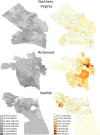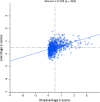Impact of Urban Neighborhood Disadvantage on Late Stage Breast Cancer Diagnosis in Virginia
- PMID: 28290007
- PMCID: PMC5391338
- DOI: 10.1007/s11524-017-0142-5
Impact of Urban Neighborhood Disadvantage on Late Stage Breast Cancer Diagnosis in Virginia
Abstract
Research suggests that residents of inner-city urban neighborhoods have higher rates of late stage cancer diagnosis. Identifying urban neighborhoods with high rates of both concentrated disadvantage and late stage cancer diagnosis may assist health care providers to target screening interventions to reduce disparities. The purposes of this study were to (1) create an index to evaluate concentrated disadvantage (CD) using non-racial measures of poverty, (2) determine the impact of neighborhood CD on late stage breast cancer diagnosis in US cities, and (3) to understand the role of obesity on this relationship. We used census block group- (CBG) level poverty indicators from five Virginia cities to develop the index. Breast cancer cases of women aged 18-65 who lived in the five cities were identified from the 2000-2012 Virginia Cancer Registry. A logistic regression model with random intercept was used to evaluate the impact of disadvantage on late stage breast cancer diagnosis. CBG-level maps were developed to geographically identify neighborhoods with both high rates of CD and late breast cancer staging. Over 900 CBGs and 6000 breast cases were included. Global fit of the concentrated disadvantage model was acceptable. The effect of disadvantage on late stage was significant (OR = 1.0083, p = 0.032). Inner-city poverty impacts risk of late stage breast cancer diagnosis. Area-level obesity is highly correlated with neighborhood poverty (ρ = 0.74, p < 0.0001) but the mediating direct and indirect effects are non-significant. Intervening in these high poverty neighborhoods may help combat disparities in late stage diagnosis for urban poor and for minorities living in these underserved neighborhoods, but more study is needed to understanding the complex relationship between concentrated neighborhood poverty, obesity, and late stage diagnosis.
Keywords: Breast cancer; Concentrated disadvantage; Neighborhood; Poverty; Stage of diagnosis; Urban health.
Figures




Similar articles
-
Disadvantaged neighborhoods and racial disparity in breast cancer outcomes: the biological link.Cancer Causes Control. 2019 Jul;30(7):677-686. doi: 10.1007/s10552-019-01180-4. Epub 2019 May 20. Cancer Causes Control. 2019. PMID: 31111277 Free PMC article. Review.
-
The importance of place of residence in predicting late-stage diagnosis of breast or cervical cancer.Health Place. 2005 Mar;11(1):15-29. doi: 10.1016/j.healthplace.2003.12.002. Health Place. 2005. PMID: 15550353
-
Neighborhood changes in concentrated immigration and late stage breast cancer diagnosis.J Immigr Minor Health. 2011 Feb;13(1):9-14. doi: 10.1007/s10903-010-9339-3. J Immigr Minor Health. 2011. PMID: 20232147
-
Detecting an association between socioeconomic status and late stage breast cancer using spatial analysis and area-based measures.Cancer Epidemiol Biomarkers Prev. 2007 Apr;16(4):756-62. doi: 10.1158/1055-9965.EPI-06-0392. Cancer Epidemiol Biomarkers Prev. 2007. PMID: 17416767
-
Social determinants of breast cancer risk, stage, and survival.Breast Cancer Res Treat. 2019 Oct;177(3):537-548. doi: 10.1007/s10549-019-05340-7. Epub 2019 Jul 3. Breast Cancer Res Treat. 2019. PMID: 31270761 Review.
Cited by
-
Social Risk Factors That Increase Cardiovascular and Breast Cancer Risk.Curr Cardiol Rep. 2023 Oct;25(10):1269-1280. doi: 10.1007/s11886-023-01957-9. Epub 2023 Oct 6. Curr Cardiol Rep. 2023. PMID: 37801282 Free PMC article. Review.
-
Effects of neighborhood disadvantage on cortisol and interviewer-rated anxiety symptoms in breast cancer patients initiating treatment.Breast Cancer Res Treat. 2023 Nov;202(1):203-211. doi: 10.1007/s10549-023-07050-7. Epub 2023 Aug 10. Breast Cancer Res Treat. 2023. PMID: 37561280 Free PMC article.
-
Structural racism and breast cancer stage at presentation in a South Florida majority-minority population: a retrospective study.Lancet Reg Health Am. 2025 Feb 26;43:100962. doi: 10.1016/j.lana.2024.100962. eCollection 2025 Mar. Lancet Reg Health Am. 2025. PMID: 40093851 Free PMC article.
-
Neighborhood disadvantage and lung cancer risk in a national cohort of never smoking Black women.Lung Cancer. 2022 Nov;173:21-27. doi: 10.1016/j.lungcan.2022.08.022. Epub 2022 Sep 8. Lung Cancer. 2022. PMID: 36108579 Free PMC article.
-
Disadvantaged neighborhoods and racial disparity in breast cancer outcomes: the biological link.Cancer Causes Control. 2019 Jul;30(7):677-686. doi: 10.1007/s10552-019-01180-4. Epub 2019 May 20. Cancer Causes Control. 2019. PMID: 31111277 Free PMC article. Review.
References
Publication types
MeSH terms
LinkOut - more resources
Full Text Sources
Other Literature Sources
Medical
Research Materials
Miscellaneous

